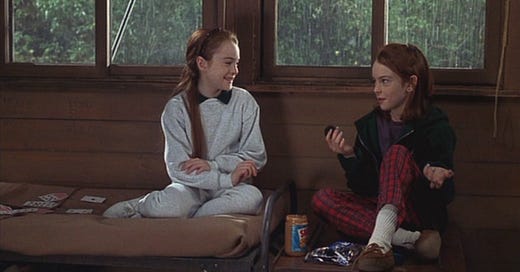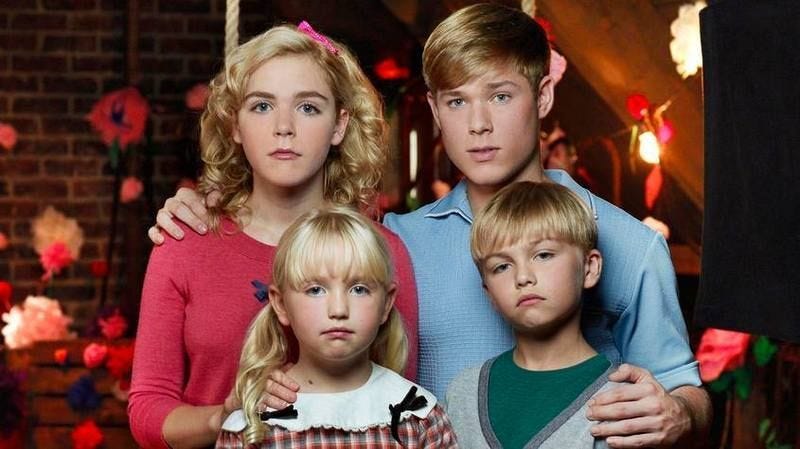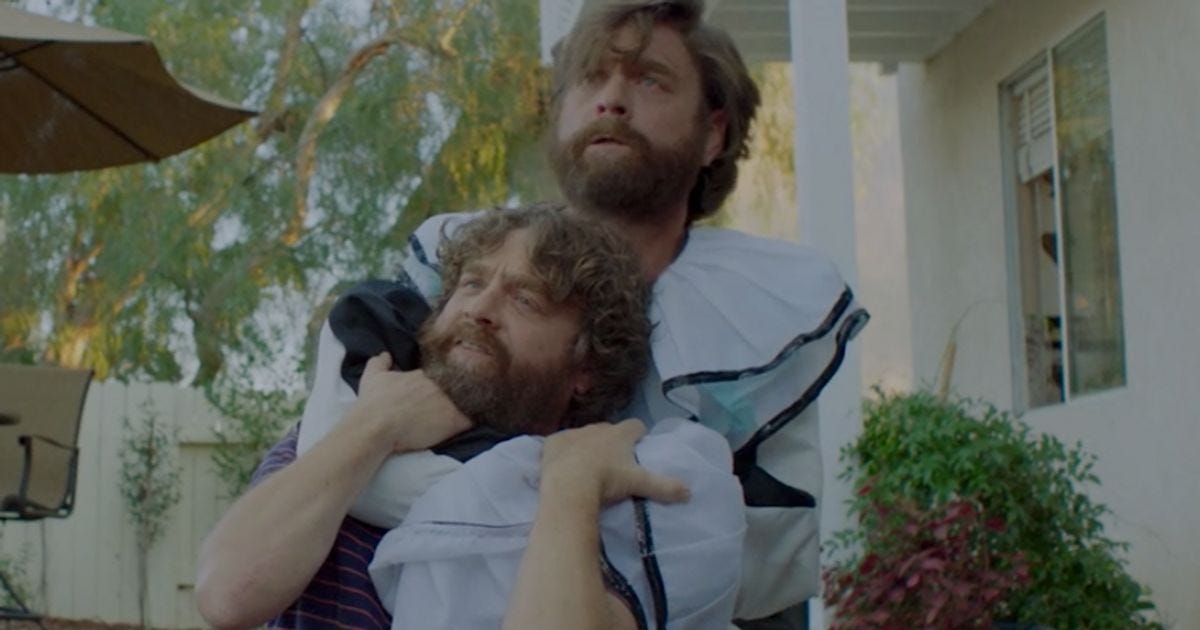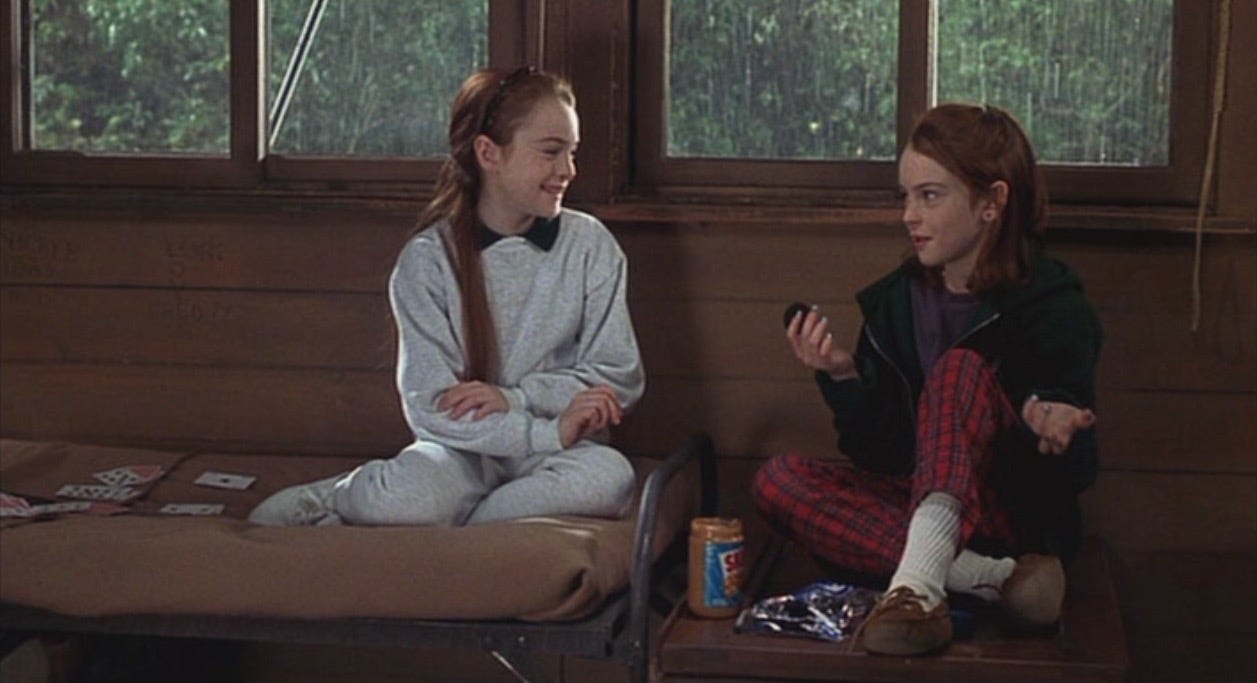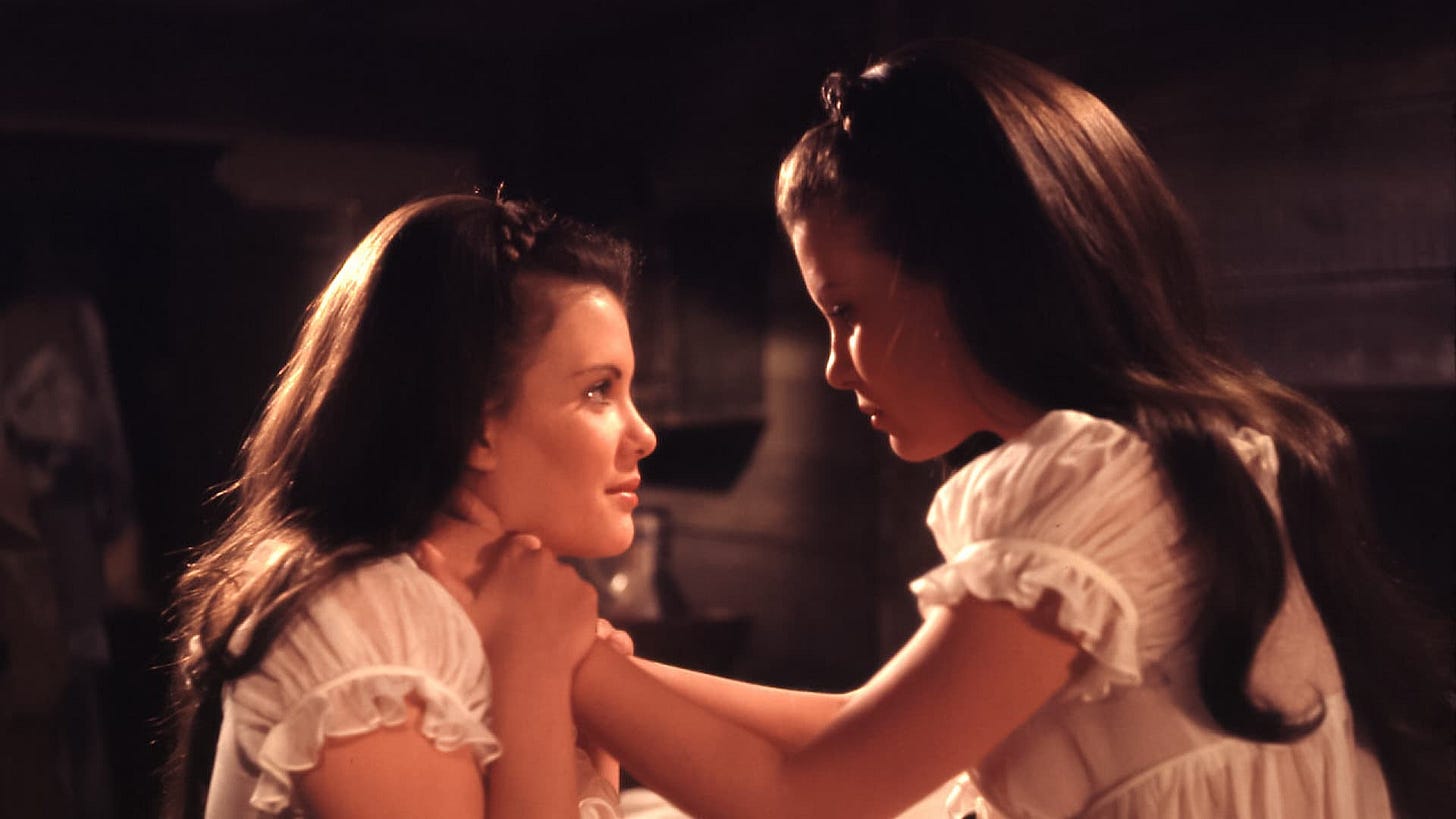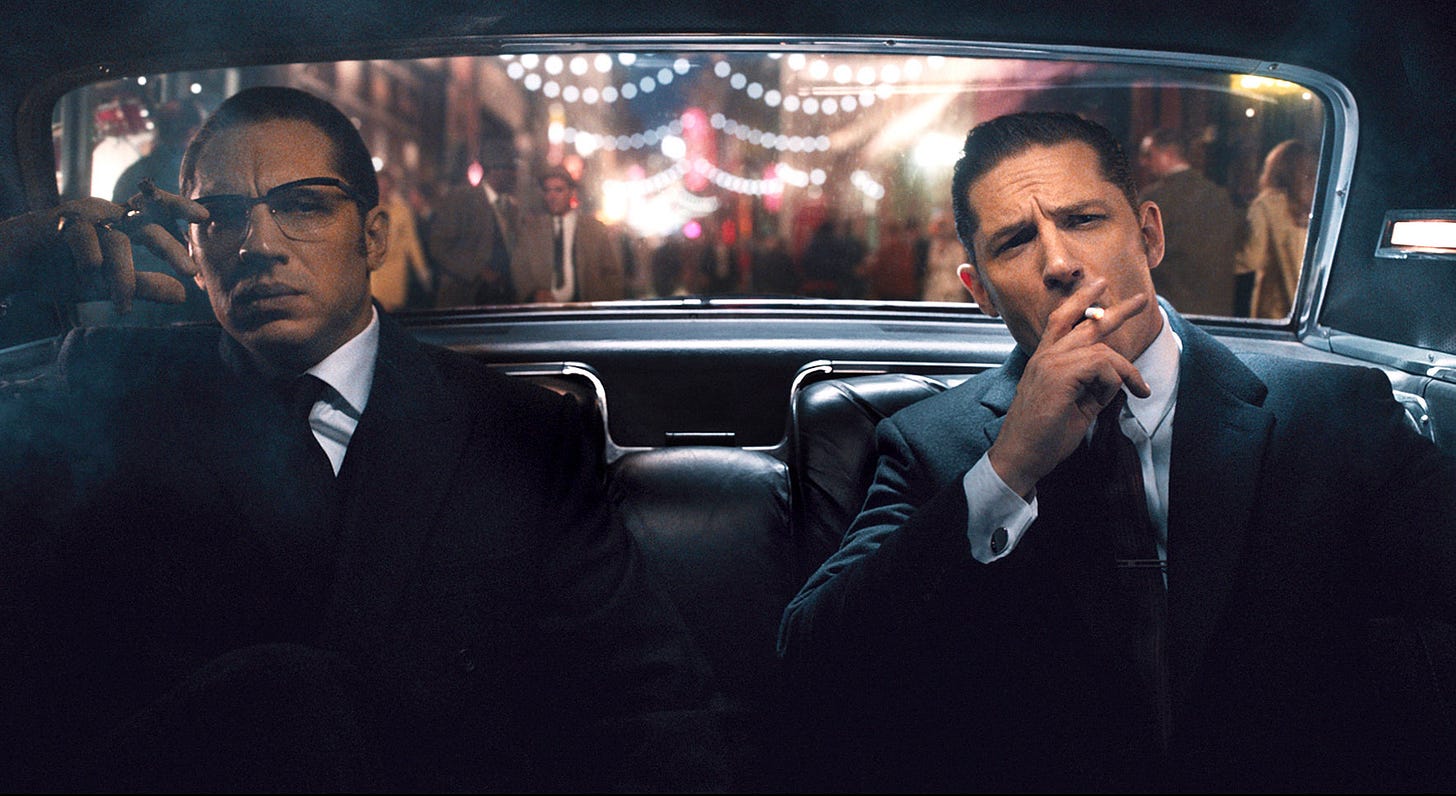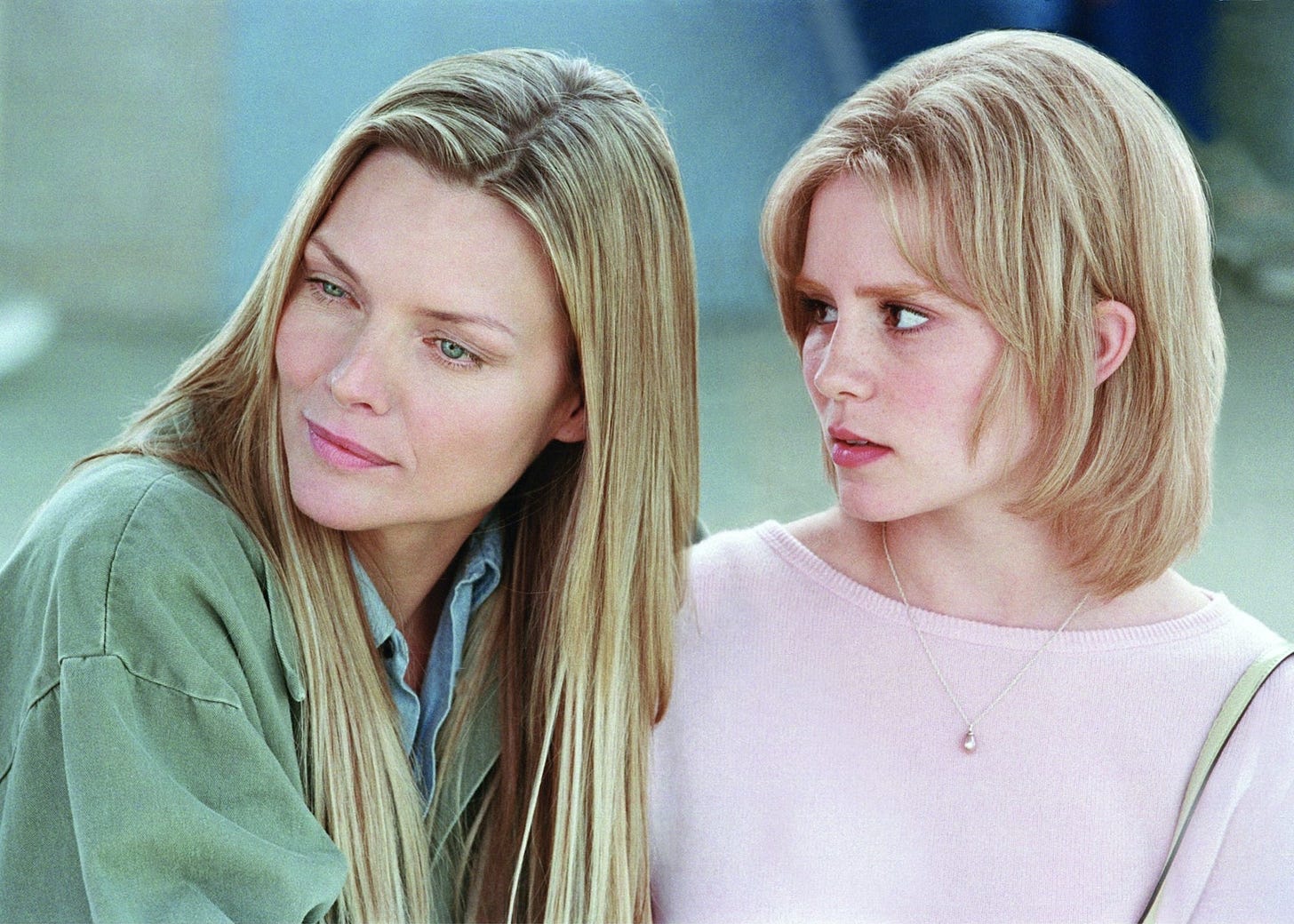Double Trouble... Issue 6: TWINS is live 👯♂️
Plus, an exclusive newsletter feature on iconic on-screen twins — and a submissions call for Issue 7: Comics & Cartoons
Issue 6: Twins
Seeing double? Our newest issue just launched! Here’s the intro to the Editor’s Note by Gabrielle Marceau:
“It occurs to me that the words around film are often singular, perhaps reflecting the hierarchy that still thrives on a film set, where the director calls the shots (literally), actors fight for top billing. There is one silver screen, the leading man, one perfect shot. And so why was our inbox flooded with doubles: twins, remakes, adaptations, couples? For the viewer, the screen provides a double: an idealized self or a funhouse mirror.”
Check out the full issue:
Newsletter Feature: Twin Binge
Warning: These On-Screen Doubles May Shake Your Sense of Self
by Dia VanGunten
Flowers in the Attic (Deborah Chow, 2014)
I’m an evil twin—greedy, jealous, stark-raving mad, and cold-bloodedly homicidal. I mean, maybe. Vanishing Twin Syndrome is not uncommon. In 20% of multiple pregnancies, twins can’t agree on the allocation of resources. So it’s really quite likely that I killed my twin in the womb. I sucked up all the air, I took more than my fair share, and cannibalism does run in my family. My cousin absorbed her twin, and now she’s walking around with extra organs, which is handy. Who am I kidding? I’m more like Cory from Flowers in the Attic: death by powdered donuts. I read Flowers in the Attic at an impressionable age, then lent the smut to a friend for her book report. It caused a whole kerfuffle. The principal demanded to know where I got such scandalous trash, so I threw Grandma under the bus. After our scolding, Grandma rented the film. I can't blame her for my malfunctions, and I can’t blame VC Andrews for my twincession. I was destined: a Gemini, born at midnight, with a built-in nom du’plicity. Dia En Noche. It’s a lotta hippy hooha, except that I am cleaved into day and night: my jeans gape at the crack of dawn.
The Patty Duke Show (1963-1966, 100 episodes)
Fog swallowed the piney woods of Mississippi at that melancholy hour, just as the horizon bled out. I’d isolated for months, on some kinda misguided artistic retreat where I mostly watched Smallville and drove a beater van to Walmart at 3 a.m. I bedded down at dawn with double episodes of The Patty Duke Show. It’s probably Patty Duke’s fault that I’ve spent the last decade writing a series of graphic novels about identical twins (and also a psychedelic series about Alexander and Hephaestion, who saw themselves as two halves of the same platonic form).
Patty Duke played Patty and Cathy Lane, Patty’s identical cousin. The implausible plot was a balm, which is often the case when we agree to suspend disbelief and go with the glitch or the kitsch. Absurdism steps in, forcing logic to release its vice grip on reality. The opening sequence had a narcotic effect, and I’d nod off to Patty and Cathy’s mirror dance-off, missing the 5:30 a.m. airing. “They look alike, they walk alike, and sometimes they even talk alike.” Even in my dream, Cathy was calmly hiding Patty’s beatnik phase from the adults, saying, “It’s our generation against yours.” America was turning away from Beaver Cleaver and toward hip-swiveling Elvis. There are clues of counterculture in the irrepressible Patty Lane and tenacious Cathy Lane. Even in reruns, I could feel the crackle of time and place. The identical cousins made me feel less lonesome. Twins have built-in besties.
Game of Thrones (2011-2019, 73 episodes) & House of the Dragon (2022-present, 11 episodes)
Sometimes twins have built-in lovers too—talk about handy. GoT’s Jaime and Cersei were two Lannister hotties going through puberty together; they were motherless and adrift, stuck with a sociopathic patriarch and a pedantic dwarf. Lust bloomed like dusty attic flowers. Studies show that there’s something about a doppelgänger that is both attractive and repulsive. We’ve all kissed the full-length mirrors on our closet doors with a fervent, probing tongue. Right? My cousin has, at least, because she had a second door with its own mirror. Not the cousin who absorbed her twin, but another one. Coz and I were globetrotting models. Our European boyfriends were handsome and rectangular, with specular complexions. Point being, puberty is weird. Game of Thrones brought twincest to mainstream TV, and now HBO’s got more twin tension in the GoT prequel, House of the Dragon. Arryk and Erryk Cargyll are members of the Kingsguard, but the twins take opposite sides in the war between the Black and Green, a detail of Westeros history. This should make for some juicy drama in the coming seasons.
Baskets (2016-2019, 41 episodes)
When Chip Baskets returns to Bakersfield after studying abroad, his twin is not impressed. Chip doesn't expect accolades from Dale. He’s not a dreamer, this character who has just returned from a snooty clown school in Paris. Chip assumes life will only abuse him. His French girlfriend says he’s not a real man—or even a real “kloon”—and she also insists that she’s not his girlfriend. Chip isn’t surprised, though she’s his legal wife. His accidental bestie is a Costco employee who has had the same sprained hand through all four seasons. And his mom… steals the show. Christine Baskets was played with such tenderness and nuance that I forgot it was Louie Anderson in a dress—or even that it was television. Zach Galifianakis had dual roles as Chip and Dale, but he also had the gracious good sense to let Anderson shine in the last major role of his life. Christine has a second set of adopted identicals: Cody and Logan, played by real-life twins, overshadow their brothers in all ways, especially in twinship. Baskets is the antidote to the “spooky twin” trope. This is a story about two brothers who don’t have much in common. Sometimes, when my internal monologue is trolling me, I adopt a French accent. You’re not a kloon. You call yourself a kloon, but you’re no kloon.
The Parent Trap (Nancy Meyers, 1998)
Like Baskets, The Parent Trap scoffs at the twin connection. When Annie and Hallie Parker end up at the same summer camp, there’s no lightning bolt of recognition, despite the fact that they look exactly alike (both are played by young Lindsay Lohan). When they do put two-and-two together, they’re more interested in the selfish parents who had one blow-out, just one thrown hair dryer, and it was game over. They each absconded with their own twin, determined to never see one another again and the Parker sisters were raised on different continents, one in a London mansion, the other on an American vineyard. Since 1989, the Minnesota Twin Study has examined 2000 sets of identicals who were separated at birth, many coming from a “Parent Trap”-style custody arrangement. One story is especially dramatic: After WWII, a mother took one son to Israel, where he was raised in a kibbutz. The other stayed in Germany with his Nazi father. For 40 years, they were not in contact, but the brothers showed up to the study in the same shirt. In the front pocket, the same pen, the same glasses. The Minnesota Twin Study helps to sort out environmental effects on the genome. Its findings have illuminated the debate on nature vs. nurture. It’s enough to trigger an existential crisis. We believe that we have a unique personality, that we choose clothing to suit us, our “spirit” essence; but, we don’t have “style,” we have genetics.
Twins of Evil (John Hough, 1971)
The Hammer Films are stylistically impressive; imagine an old dusty novel, a bodice ripper, with two distressed maidens in white nightgowns and a gray castle looming in the background. The final installment of the Karnstein Trilogy, Twins of Evil, is another Freudian fairytale about familial shame and societal oppression. After the death of their parents, the Collinson twins are forced to leave cosmopolitan Venice. They are exiled to the Austrian countryside, where fog swallows treetops and witches are burned at the stake. Uncle Gustav is the sharpest pitchfork. In the role of Gustav, Peter Cushing is reliably creepy as he eradicates witches and lectures the twins on their feathered hats. The twins are prisoners to Protestant morality. The best moment in the film is Frieda’s gaze of mischievous longing when she first lays eyes on a local vampire. He’s shady, so obviously sus, but Frieda is looking for trouble. Maria and Freida Gellhorn were played by Madeleine and Mary Collinson, Playboy playmates and real-life twins. There’s delicious onscreen chemistry between these celluloid sisters and that chemistry, the struggle, speaks to our twinned desire. On one hand, we long to follow temptation. On the other hand, we are survival-minded, adapting to societal demands. Perhaps if Uncle Gustav had let these sisters wear feathers, they wouldn’t be so vulnerable to vampires.
Dead Ringers (David Cronenberg, 1988) & Legend (Brian Helgeland, 2015)
When I conducted a social media survey on the best twin films, there were three camps: The Parent Trap, Legend, and Dead Ringers. I had never seen the latter, but I do enjoy a good Cronenberg mind-fuck, so I cued it up. Immediately, anxiety’s claw clenched in my chest. The Mantle Brothers, played by Jeremy Irons, felt too similar to the twins in my work-in-progress, but we share inspirations: the sleazy B’s and mirror pairs. And Cronenberg did the same exhaustive research on the psychology of twins—psychic enmeshment, pathological fairness, and the Lacanian breast. As the movie goes on, the B-movie element deepens, becoming a homage. It’s inevitable that one twin will end the film in the fetal position, weeping in the lap of his brother. It’s reminiscent of a scene in Legend, where gangster twins Ronnie and Reggie Kray are on the floor, limbs entangled. Reggie has restrained the homicidal Ron, who is weeping in his brother’s arms, referring to himself as “fragile.” The evil twin trope is most effective when it’s unclear which twin is good and which is evil, when they flip-flop or become somehow indiscernible. Legend opens with an evil twin set-up but tells a more nuanced story. Like in Dead Ringers, a woman threatens the geminal balance, but Legend doesn’t focus on the duo. This story is about a triad—a relationship between three (the twins and a wife), for better or worse. Her husband’s twin is a thorn in her side, but Ronnie might know Frances better than Reggie. (She should’ve married Tom Hardy in real life. The actor is both Krays in one well-built body.)
Silent Twins (Agnieszka Smoczynska, 2022)
Real-life twins, June and Jennifer Gibbons, shared a vivid fantasyland, even their own language. At times, they only spoke to one another. Selective mutism might be explained by the family’s move to the UK, where the Caribbean immigrants struggled to fit in, especially the twins. Their autistic and artistic world-making was expressed through gorgeous sequences of the girls crafting grotesque dolls and putting on surreal puppet shows. Worth a watch for this alone, because it’s stunning. The film simplified a complex dynamic, blaming their troubles on Jennifer but she was a real person and it can’t be that simple. The “evil twin” trope does them an injustice, which is fitting since their whole story was unjust. They committed minor adolescent crimes of the “boys will be boys” variety, but they weren’t like the boys they admired and fucked: they were black girls. For petty crime and simple vandalism, the Gibson sisters were imprisoned at Broadmoor, a high-security hospital for the criminally insane. Violent offenders like the Yorkshire Ripper were imprisoned alongside the Gibbons twins. The girls attended institutional sock hops with male inmates and they even encountered another set of criminal masterminds, THE KRAYS. Ronnie Kray was serving time for murder, while the twins were sentenced to Indefinite Detention under the Mental Health Act of 1893. After 11 years, they were transferred from Broadmoor to Caswell Clinic in Wales. The release was a second chance at life, but the twins believed that one of them had to die so that her sister could live. Jennifer died on the ride to Wales. She was only 29.
Dia VanGunten explores overlaps between genres, between poetry & prose, between real & magical.
…and a few of our favourite pieces from Issue 6
The Two Gentlemen of Harvard: Unpacking my Love for the Winklevii
by Kathryn Margaret Rose
“It’s about the cognitive dissonance between the belief you have in someone’s character, and then seeing how they treat you when the shit hits the fan. As we speak, Mark Zuckerberg is pushing his Metaverse agenda while performing mass layoffs at his company. Cameron and Tyler Winklevoss are mired in a crypto scandal and owe investors $900 million. People fall off their pedestals. Everything is constructed. No one is as they seem.”
Read More →
Cason’s Casting Couch: White Oleander
by Cason Sharpe
“It’s a movie about many things: artistic ethics, lonely children and selfish parents, learning how to function in a world without guardians, sacrifice, state failure, emotionally devastated blonde women. Critically well-received but understated enough to fall into cult classic territory, White Oleander remains one of the most elegant and moving high-camp melodramas of the last few decades.”
Read More →
Another Stacy London Poem
by Jenna Jaco
“She flicks hard truths into the 360-degree mirror,
laughs like a dolphin, sprinkles enough “you’re worth it”s and
sympathetic head tilts to make people hug her as they cry”
next to a trash can filled with all their clothes.”
Read More →
Submissions OPEN for Issue 7
We’re now accepting submissions for Issue 7: Comics & Cartoons until March 31st. Pitch us your ideas on animated films, comic book adaptations, kids cartoons, and more:
Wondering what to watch?
Choose a mood on our Film Recommendation Generator and get a curated pick from writers, filmmakers, poets, and artists.
Donate
If you’d like to donate to our mag you can do so through our PayPal! We're volunteer-run, and donations go directly to the mag and contributor honorariums.

